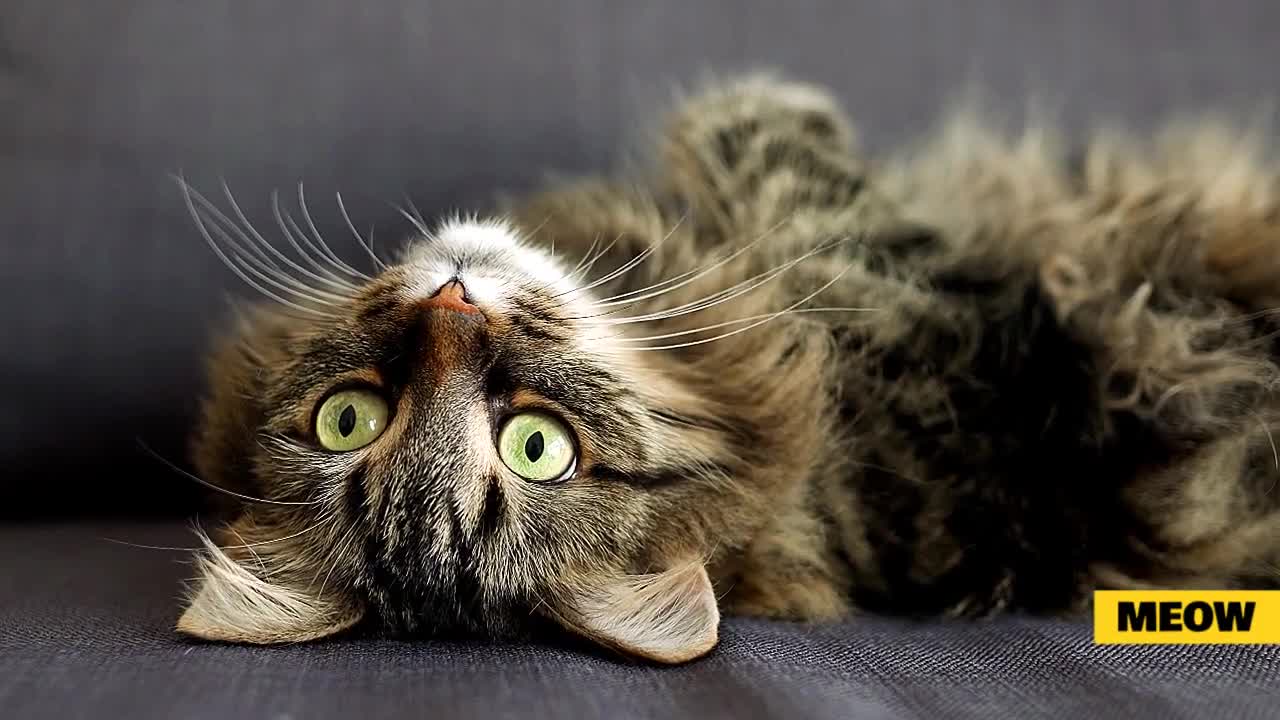Premium Only Content

Cat Meow Meaning
In today's video, we are going to talk about Cat's Meow Meanings.
Cat language is composed of a combination of body postures, scent signals, and vocalizations. Humans are scent-blind compared to cats, and we often overlook tail talk and ear signals that make up the majority of cats' communication.
Think your cat’s meows, chirps, yowls, and purrs are just random gibberish? She’s actually communicating to you information about her world and about how she feels toward you. The good news is that if you listen closely, you just might begin to understand what the sounds your cat makes is all about and use that understanding to your advantage.
Cats possess the widest range of vocalizations of any domestic pet. Though best known for their meows, purrs, hisses, and growls, the list of sounds they regularly make is more comprehensive than this. Depending on the situation, your cat is capable of making many distinct utterances, with multiple nuanced variations of each, according to importance. Some reflect contentment and ease, while others expose worry, fear, or even anger. All are indicative of your cat’s emotional state of mind.
Meow.
Perhaps the most commonly heard cat sound, the meow of an adult cat is almost exclusively used to communicate with humans, and not other cats. First uttered by kittens when in need of their mothers, this juvenile vocalization fades away as wild cats mature. But, as cats in domesticity tend to think of themselves as our eternal offspring, they maintain this endearing vocalization throughout their adult lives. Generally, a meowing cat wants something, attention or food, or perhaps access to a room. Sometimes though, meows simply serve as a “welcome home” salutation.
Occasionally, a meow can signify loneliness or even illness. Older cats often meow more because of failing senses or due to anxiety over not being as nimble as before. In younger cats, the meow often gets shortened to an interrogative, “mew?”, when lonely or hungry. And the frequency of meowing is an indicator of a cat’s frame of mind, rapid-fire meows mean hey, pay attention to me, I’m talking here!
A longer, more plaintive “meow” can indicate worry, annoyance, or objection to something. This version will often have a throatier quality to it, almost as if she is saying, “oh, come on.” And incessant meowing could indicate illness or injury, if you suspect this, consider a trip to the veterinarian.
Purr.
Perhaps the most enjoyable and hypnotic of cat sounds, the purr is a soft, deep, throaty rumble, most often made when your cat is in the best of moods. Gently petting your cat while she nests in your lap is a sure way to bring forth this motoring sound of utter contentment.
On rare occasions, purring can occur when your cat is agitated over something. It’s similar to how you might nervously whistle or hum while waiting for in-laws to arrive for dinner. The key to discerning this “worry-purr” is body posture, if your cat’s ears are back and her body seems tense, the purr denotes concern over something.
Chirps, Trills, and Chirrups.
Learned in kittenhood, these birdlike utterances are slightly more declarative than a meow. Originally used by mothers to tell kittens to pay attention and follow her, your cat may chirp in an effort to get you to pay attention to her or as a way to get you to check out something she deems important. Chirrups and squeaky little trills might also happen when a cat is excited and happy.
Chatter.
You might have heard your cat chatter her teeth while longingly staring out a window at a sparrow or squirrel in a tree. Sometimes accompanied by a chirp, squeak, or faint cry, the chatter is thought to be an indicator of a cat’s predatory excitement and of her stress at not being able to get to the prize. Some claim the chatter is actually a mimicked bird or rodent call, but this is anecdotal at best as the hunting prowess of cats is dependent on silence and stealth.
Hiss.
There is no mistaking the intent of a cat’s hiss. Sounding like a steak sizzling on the grill, it means your cat feels threatened and is ready to fight if need be. A big, goofy dog who gets too chummy with your feline is sure to provoke a hiss and perhaps more. Along with the threatening sound comes a change in a cat’s body language, including an arched back, puffed hair, twitchy tail, flattened ears, and an open mouth, fangs ready to strike. Spitting can also occur with a hiss. When your cat takes on this serpent-like guise, back off, and do what you can to remove the perceived threat.
-
 35:21
35:21
Tactical Advisor
1 hour agoNew Gun Unboxing | Vault Room Live Stream 028
12.4K2 -
 1:25:20
1:25:20
Michael Franzese
19 hours agoAre We Headed for Collapse? War, Riots and Political Tension | LIVE
21.5K40 -
 LIVE
LIVE
JdaDelete
1 hour agoDuke Nukem 3D - Sega Saturday
101 watching -
 DVR
DVR
THOUGHTCAST With Jeff D.
1 hour agoFlag Day & Fortnite. News and Protest watch Game Chat with Jeff D.
57 -
 21:48
21:48
World2Briggs
13 hours ago $0.03 earned10 Towns Almost Begging People To Buy A Cheap Home
1881 -
 21:46
21:46
marcushouse
6 hours ago $0.14 earnedSurprising changes to Starship Super Heavy! Why are they doing this?
2294 -
 1:53:33
1:53:33
Squaring The Circle, A Randall Carlson Podcast
3 hours agoGreat Pyramid's Big Void is Finally Being Opened ft. Matt Beall - Squaring The Circle
3.42K1 -
 1:55:20
1:55:20
I_Came_With_Fire_Podcast
13 hours agoIRAN Tried to KILL HER for HACKING Mass SURVEILLANCE Of Women
29.4K4 -
![[ Sabotage Saturday ] Tekken 8 and CHiLL](https://1a-1791.com/video/fww1/0c/s8/1/r/W/j/T/rWjTy.0kob.1-small--Sabotage-Saturday-Tekken-8.jpg) 2:17:59
2:17:59
CHiLi XDD
4 hours ago[ Sabotage Saturday ] Tekken 8 and CHiLL
18.1K1 -
 1:41:48
1:41:48
The Mike Schwartz Show
3 hours agoTHE MIKE SCHWARTZ SHOW with DR. MICHAEL J SCHWARTZ No King's (Morons) Day Special!
6.49K